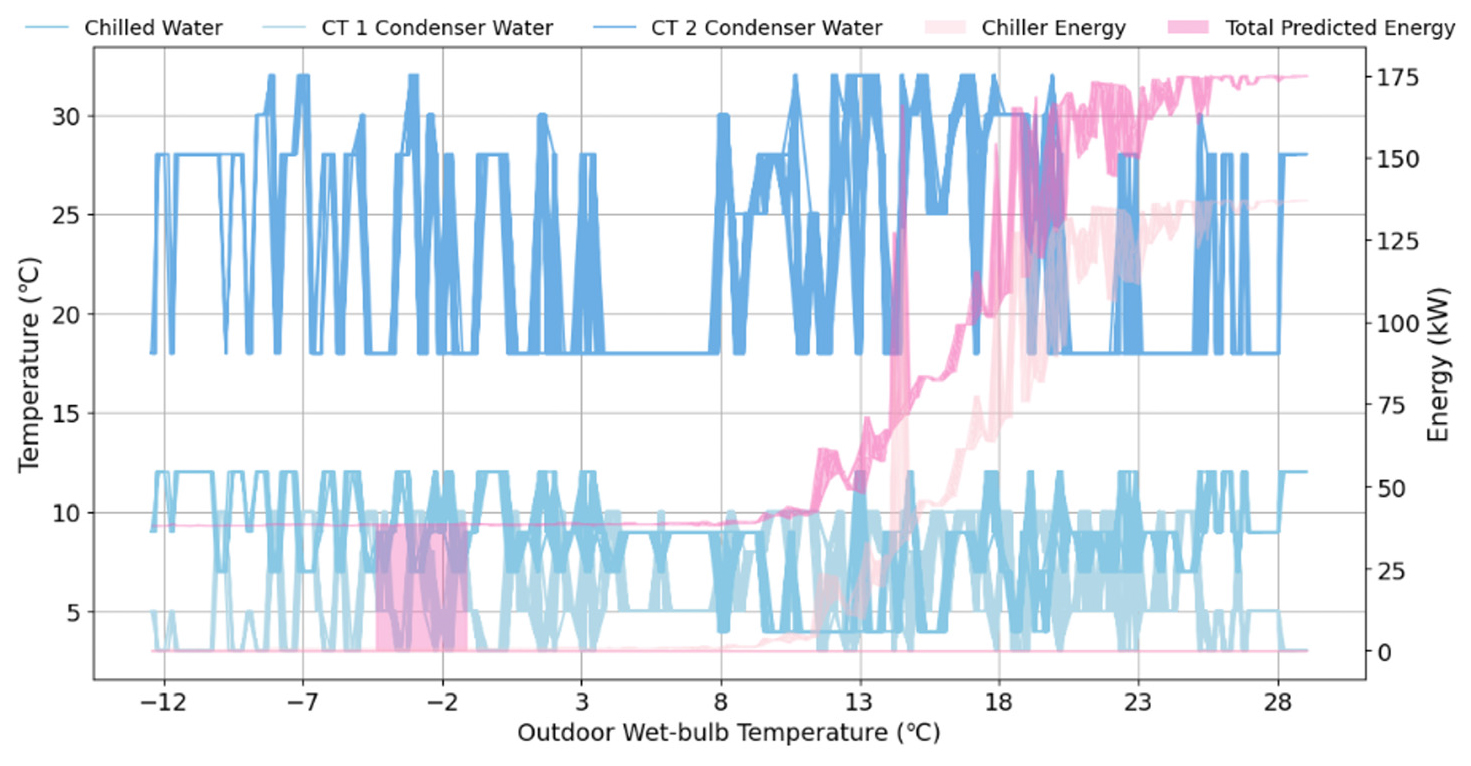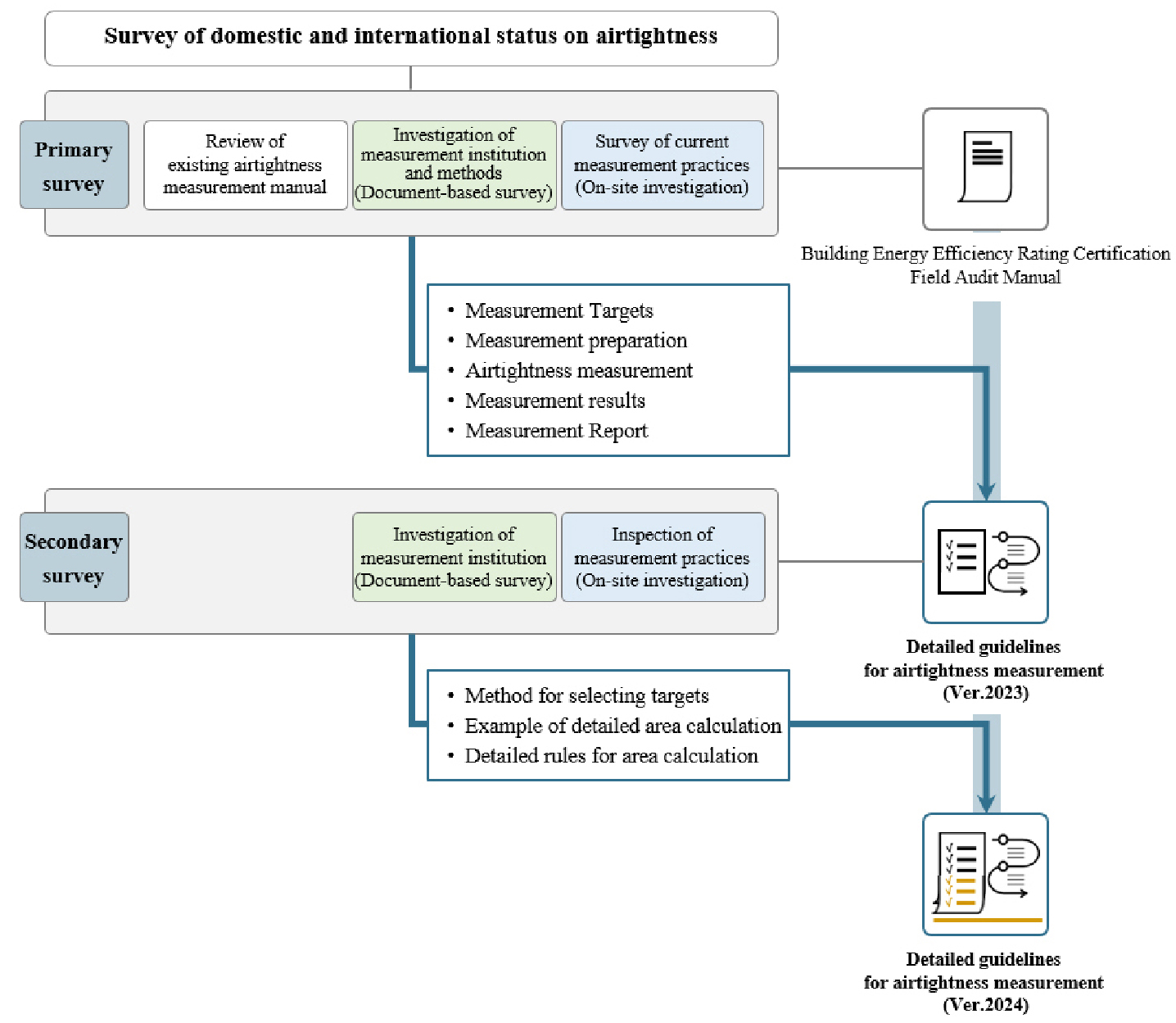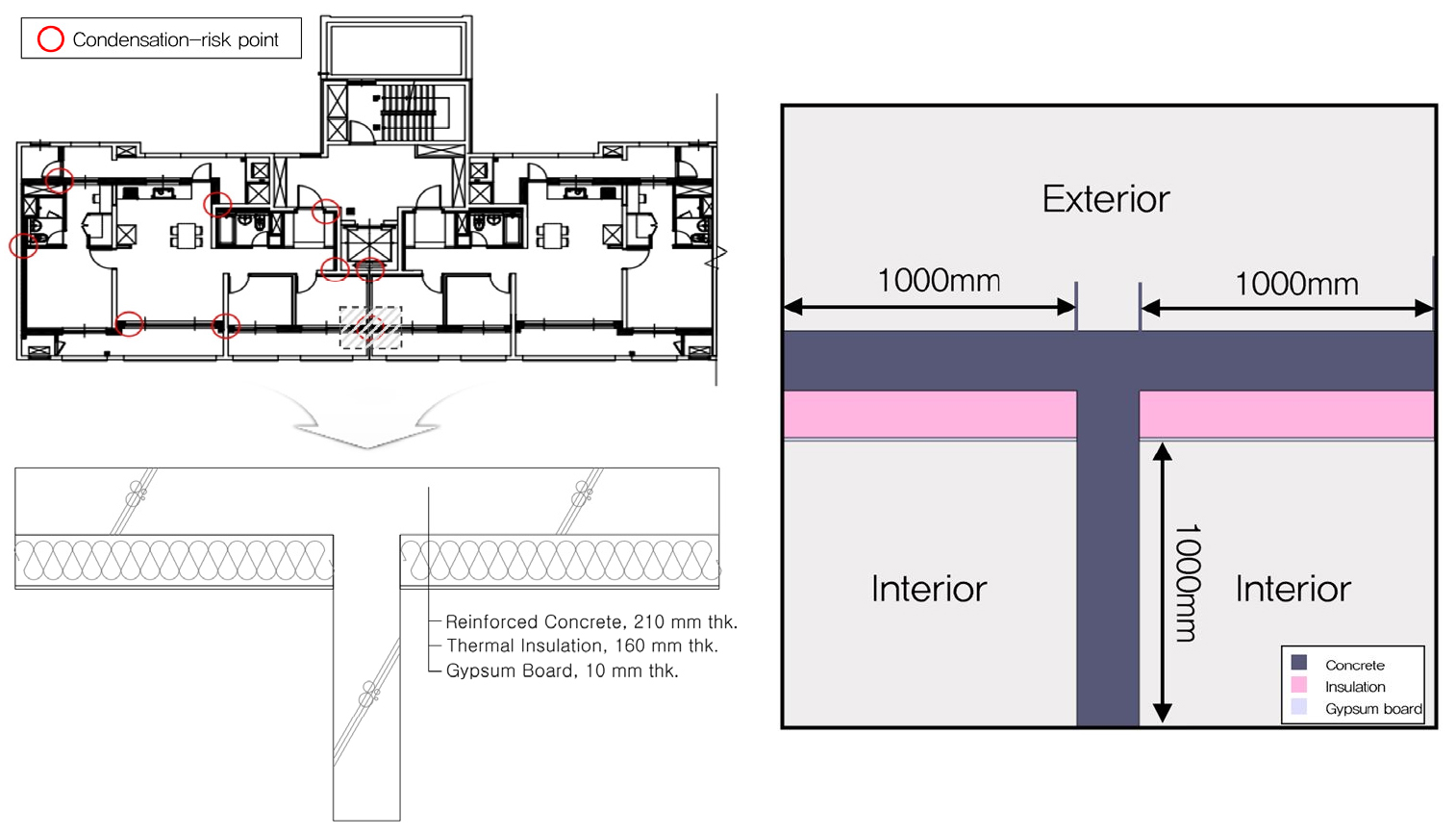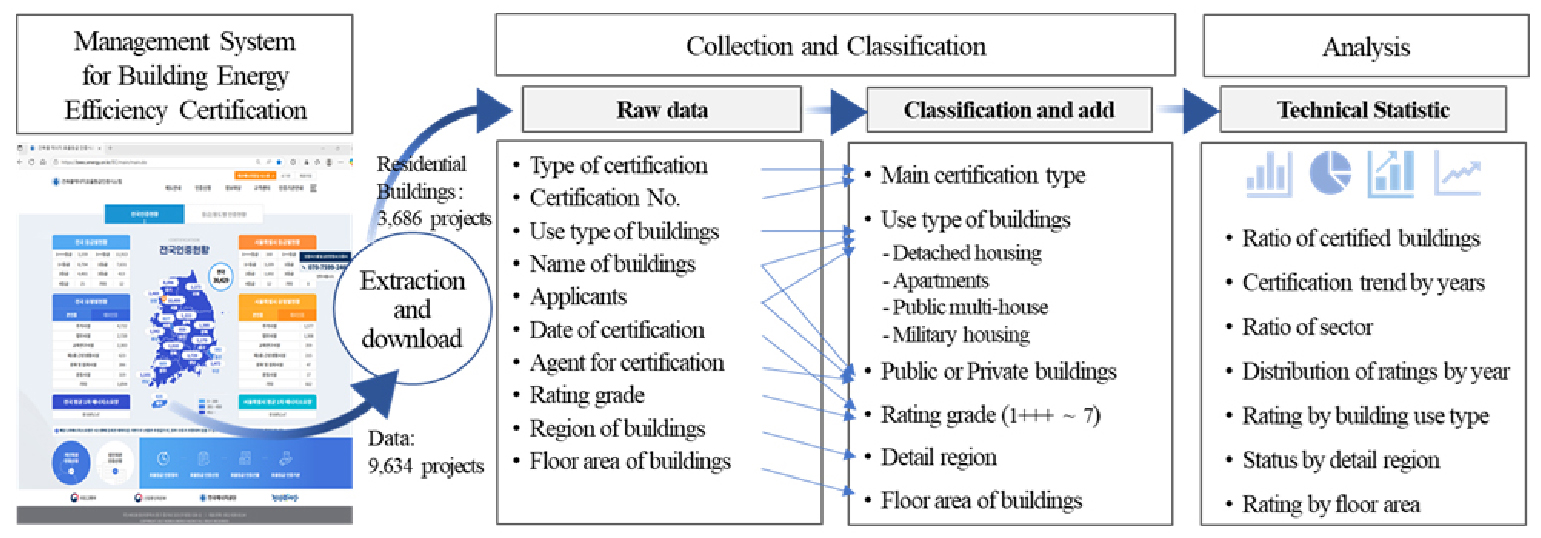-
Research Article

-
A Study on the Derivation of Optimal Fluid Temperature by Outdoor Wet-bulb using Energy Predicted Model in Data Center
데이터센터 에너지 예측 모델을 활용한 외기습구온도별 최적 유체 온도 도출에 대한 연구
-
Go, Su-Min, Song, Young-Hak
고수민, 송영학
- As societal demands for carbon neutrality continue to rise, reducing energy consumption in the building sector has become essential. Among various building …
- As societal demands for carbon neutrality continue to rise, reducing energy consumption in the building sector has become essential. Among various building types, data centers consume a significant amount of energy, prompting numerous studies to explore the application of Water-side Economizer (WSE) systems that enable Free Cooling operation for enhanced energy efficiency. This study aims to optimize the performance of WSE systems by proposing a control strategy that minimizes cooling energy consumption in response to varying outdoor conditions. As a preliminary step, a cooling energy prediction model for a data center was developed to derive optimal fluid temperature setpoints that minimize energy usage according to outdoor wet-bulb temperature. The predictive model was constructed using Long Short-Term Memory (LSTM) and Light Gradient Boosting Machine (LightGBM), and demonstrated high accuracy and reliability with R-squared value of 0.995, CV (RMSE) of 4.31%, and an MAE of approximately 1.13 kW. Based on this model, optimal fluid temperature combinations were determined for each outdoor wet-bulb condition throughout the year. These results are expected to serve as a foundational guideline for developing future control algorithms and establishing energy-efficient operation strategies. - COLLAPSE
-
A Study on the Derivation of Optimal Fluid Temperature by Outdoor Wet-bulb using Energy Predicted Model in Data Center
-
Research Article

-
Derivation of Conversion Factor N for Evaluating Natural Air Infiltration Rates
기밀성능 데이터를 이용한 자연상태 침기량 산정을 위한 변환계수 N 도출
-
Lim, Su-Jin, Jo, Jae-Hun, Kim, Ji-Hyoung, Seo, Ju-Hee, Shin, Ha-Kyung, Kim, Doo-Yeon, Jeong, Hyeon-Chul
임수진, 조재훈, 김지형, 서주희, 신하경, 김두연, 정현철
- The evaluation of natural air infiltration rates in buildings commonly uses the ACH50 value divided by an N-factor, but the standard N-factor …
- The evaluation of natural air infiltration rates in buildings commonly uses the ACH50 value divided by an N-factor, but the standard N-factor of 20, derived from foreign contexts, may not accurately reflect Korean conditions. This study seeks to propose a more suitable N-factor using a theoretical model that incorporates pressure differences arising from the stack effect, wind, and mechanical systems. Pressure differences were calculated by analyzing 25 years of wind speed and outdoor temperature data (2000–2024) and validated through statistical methods, including normality tests. Additionally, Blower Door Test results from over 1,400 residential buildings were analyzed, with outlier removal conducted during preprocessing. The representative pressure differences were applied to leakage functions to compute N-values, and probability density functions were used to calculate weighted representative values. Findings reveal significant variations based on building height and seasonal changes. High-rise buildings are especially impacted by the stack effect, while low-rise buildings show less variation. The highest N-factor was observed in summer, reflecting the smaller temperature difference between indoor and outdoor environments, which results in a lower estimated infiltration rate. Conversely, the larger temperature difference exceeding 10℃ during winter enhances stack-driven infiltration, leading to a lower N-factor.By deriving an N-factor tailored to Korea’s building environment, this study improves the accuracy of natural air infiltration rate calculations and enhances energy modeling efficiency. - COLLAPSE
-
Derivation of Conversion Factor N for Evaluating Natural Air Infiltration Rates
-
Research Article

-
Causal Effect of Enhanced Insulation Levels on Heating Energy Consumption in South Korean Apartments
인과추론 기반 국내 아파트 단열 강화의 난방에너지 절감 효과 분석
-
Yoo, Young-Seo, Park, Cheol-Soo, Kim, Deuk-Woo, Ahn, Ki-Uhn
유영서, 박철수, 김덕우, 안기언
- The Korean government has continuously reinforced insulation standards in residential buildings to reduce heating energy consumption. This study applies causal inference to …
- The Korean government has continuously reinforced insulation standards in residential buildings to reduce heating energy consumption. This study applies causal inference to evaluate their effectiveness, estimating the “pure effect” of insulation improvements by isolating the influence of other factors. A dataset of 1,313 apartment buildings was selected by linking the national building register, meteorological data, and energy consumption data. Insulation level was defined as the treatment variable representing the policy intervention, while heating energy use intensity (EUI) served as the outcome. Heating degree days and apartment sale prices were incorporated as confounders, as they affect both insulation levels and heating EUI. The CausalForestDML method was applied to estimate both average treatment effects (ATE) and conditional average treatment effects (CATE). Results show that correlation-based approaches tend to overstate energy savings, whereas causal inference provides more moderate and reliable estimates after accounting for climatic and socioeconomic factors. Furthermore, the effectiveness of insulation improvements varied by baseline thermal performance, regional climate conditions, and socioeconomic characteristics, indicating substantial heterogeneity in policy impacts. These findings highlight the value of causal inference as a rigorous framework for policy evaluation, enabling more objective assessment and supporting the design of effective, targeted energy-saving strategies. - COLLAPSE
-
Causal Effect of Enhanced Insulation Levels on Heating Energy Consumption in South Korean Apartments
-
Research Article

-
Improving Building Airtightness Quality through Enhanced Measurement Guidelines Based on Field Surveys
에너지효율등급 본인증 실태조사를 통한 건물 기밀성능 측정지침 개선
-
Choi, Su-Ji, Park, So-Yi, Ji, Kyung-Hwan, Jo, Jae-Hun
최수지, 박소이, 지경환, 조재훈
- This study investigates the factors that influence airtightness measurement values, and proposes guidelines to improve the consistency and reliability of airtightness testing. …
- This study investigates the factors that influence airtightness measurement values, and proposes guidelines to improve the consistency and reliability of airtightness testing. To evaluate current practices and the status of airtightness measurements, a survey of airtightness testing institutions in Korea was carried out. The results showed that many of the requirements set out in the ISO 9972 standard were not fully met, and that there were inconsistencies in the application of baseline conditions among institutions. To improve tester proficiency, equipment performance and measurement procedures, guidelines were developed that set out requirements for testing institutions and provide detailed instructions for improving measurement protocols. Although enhancing the measurement guidelines is expected to improve consistency, the study emphasises the necessity of institutional reforms to bolster tester proficiency and guarantee the adequacy of measurement equipment for sustained quality enhancement. - COLLAPSE
-
Improving Building Airtightness Quality through Enhanced Measurement Guidelines Based on Field Surveys
-
Research Article

-
A Preliminary Simulation Study for In-Situ Diagnosis of Thermal Bridges
현장 열교 진단을 위한 시뮬레이션 기초연구
-
Kim, Seon-Bin, Kim, Seon-In, Park, Seung-Hoon, Park, Duk-Joon, Kim, Eui-Jong
김선빈, 김선인, 박승훈, 박덕준, 김의종
- In thermal bridge assessment, the linear thermal transmittance (Ψ-value) is commonly calculated under steady-state conditions. However, such steady-state analysis, typically derived from …
- In thermal bridge assessment, the linear thermal transmittance (Ψ-value) is commonly calculated under steady-state conditions. However, such steady-state analysis, typically derived from design-document–based simulations, is unsuitable for in-situ measurements because actual field environments are dynamic and variable. Before establishing an appropriate in-situ measurement methodology, this study serves as a preliminary investigation that uses dynamic-state simulations to replicate field conditions and analyze their impact on Ψ-value estimation. The simulations incorporated time-varying boundary conditions, and Ψ-values derived from dynamic heat flux data were compared with those obtained from steady-state analysis. Indoor–outdoor temperature difference, solar radiation, and wind speed were identified as key factors, and their effects were examined through trend and sensitivity analyses. Based on this analysis, optimal measurement conditions were proposed, reducing the average Ψ-value by approximately 6% compared to steady-state estimates, suppressing apparent outliers, and lowering the standard deviation by 41.1%, thereby improving data reliability. These results indicate that applying the proposed conditions in field measurements using a heat flux meter can lead to more quantitative and reliable estimates, and that dynamic simulation can be an effective preliminary step toward developing robust in-situ diagnostic methods for thermal bridges. - COLLAPSE
-
A Preliminary Simulation Study for In-Situ Diagnosis of Thermal Bridges
-
Research Article

-
Analysis and Policy Suggestions of Status of Building Energy Efficiency Certificate in Residential Buildings
주거건물의 건축물 에너지효율등급 인증 현황 분석 및 정책적 제언
-
Jeong, Young-Sun
정영선
- One of the important policies to reduce building energy consumption and greenhouse gases is ‘building energy efficiency certificate’ in Korea. However, there …
- One of the important policies to reduce building energy consumption and greenhouse gases is ‘building energy efficiency certificate’ in Korea. However, there has been no systematic analysis on the acquisition status of the building energy efficiency grade. The purpose of this study is to analyze the certification acquisition data of residential buildings from 2013 to 2023, when certification status statistics were secured. 3,686 certified residential buildings were analyzed. As a result of the study, the number of certified residential buildings continued to increase from 181 in 2013 to 1,593 in 2023. The certification of grade 1 is the highest at 37.1%. The frequency of acquisition of grades 1+ and 2 is the next highest. Apartments were the highest certified building use at 95.0%. The number of cases of buildings of 10,000 m2 or more obtaining certification is 2,230 cases (70.0%). Many of the residential buildings in Korea are buildings of 500 m2 or less, and policy supplements related to the building energy efficiency certification system are required so that many buildings can be energy-efficiently constructed. - COLLAPSE
-
Analysis and Policy Suggestions of Status of Building Energy Efficiency Certificate in Residential Buildings
-
Research Article

-
Causal Analysis to Building Vintage and Heating/Cooling Energy Consumption in Korean Office Buildings
국내 사무소 건물의 준공연도와 냉난방 에너지 사용량에 대한 인과적 해석
-
Yoo, Young-Seo, Park, Cheol-Soo, Kim, Deuk-Woo, Ahn, Ki-Uhn
유영서, 박철수, 김덕우, 안기언
- Causal inference is emerging as an essential framework for advancing evidence-based decision-making in the building energy sector. This study analyzes the causal …
- Causal inference is emerging as an essential framework for advancing evidence-based decision-making in the building energy sector. This study analyzes the causal effect of building vintage on heating and cooling energy use in 762 office buildings in South Korea. Building vintage was defined as a proxy for improvements in insulation, equipment efficiency, and regulatory standards. The analysis employed the Causal Forest Double Machine Learning (CausalForestDML) method to estimate both average treatment effects (ATE) and conditional average treatment effects (CATE), while controlling for floor area, climate conditions, and heating systems. The results show that, unlike correlation-based analysis, causal inference explicitly reveals the influence of confounding factors. Moreover, the estimated effects of building vintage diverged between heating and cooling: heating use generally declined in newer buildings but increased in small ones, whereas cooling use tended to rise in newer medium- and large-sized buildings across most regions. These heterogeneous effects indicate that the performance improvements of new office buildings are not uniform and underscore the need for tailored strategies that account for building size, system type, and regional context. Overall, this study demonstrates that causal inference not only addresses the limitations of correlation-based approaches but also provides a reliable framework for supporting evidence-based policy design and performance improvement in the building energy domain. - COLLAPSE
-
Causal Analysis to Building Vintage and Heating/Cooling Energy Consumption in Korean Office Buildings
-
Research Article

-
A Study on the Actual Conditions and Satisfaction with the Lighting Environment in University Classrooms
대학교 강의실 빛 환경 실태조사 및 만족도 조사에 관한 연구
-
Lee, Sun-Young
이선영
- This study examined university classrooms in Korea by measuring illuminance levels, investigating the use of lighting fixtures and blinds, and analyzing students’ …
- This study examined university classrooms in Korea by measuring illuminance levels, investigating the use of lighting fixtures and blinds, and analyzing students’ subjective perceptions. The results showed that natural lighting was insufficient, while excessive illuminance was caused by artificial lighting. In 64% of classrooms, blinds blocked natural light, and 86% operated with more than half of the general lighting, creating conditions unsuitable for both textbook- and projection-based instruction. Survey results indicated that textbook readability required about 340 lx, with a stable visual environment achieved at 600 lx, consistent with the KS A 3011 standard. However, students perceived levels above 891 lx as “bright.” These findings demonstrate that classroom lighting plans focusing only on horizontal illuminance do not adequately address the needs of digitalized learning environments. Future classroom lighting design should therefore consider not only illuminance levels but also light source arrangement, blind operation, and screen reflectance to improve visual comfort. - COLLAPSE
-
A Study on the Actual Conditions and Satisfaction with the Lighting Environment in University Classrooms
-
Research Article

-
Microclimate Improvement Effects of Planting Plans in Aging Residential Complexes in China
중국 노후 공동주택단지 식재계획에 따른 미기후 개선 효과 검토
-
Yu, Zi-Jian, Lee, Su-Min, Yoon, Seong-Hwan
우자건, 이수민, 윤성환
- The purpose of this study is to identify the necessity of improving external environmental quality in the regeneration of old residential complexes …
- The purpose of this study is to identify the necessity of improving external environmental quality in the regeneration of old residential complexes and to analyze the influence of outdoor spatial planning elements on thermal comfort. The Chegongzhuang district in Xicheng, Beijing, was selected as the case study area, and its land use, building and population density, transportation systems, greening patterns, public spaces, and facility distribution were examined. Three typical block layouts—linear, enclosed, and mixed—were analyzed in terms of spatial organization, internal circulation, public zones, and greenery. Using ENVI-met simulations, the impacts of pavement materials and greening strategies on outdoor thermal comfort were quantitatively evaluated. The results show that high-albedo pavement can reduce air temperature by about 1°C but increases radiant heat load in unshaded areas. In contrast, increasing the green coverage ratio from 12% to 33% lowered PET by up to 4°C, and taller trees improved thermal comfort by as much as 10°C. Mixed tree–shrub planting was more effective than single-species arrangements. Overall, greening strategies proved more effective than pavement modifications in enhancing outdoor thermal comfort, emphasizing the need for integrated consideration of vegetation design and material selection in the sustainable regeneration of old residential complexes. - COLLAPSE
-
Microclimate Improvement Effects of Planting Plans in Aging Residential Complexes in China
Journal Informaiton
 Journal of Korean Institute of Architectural Sustainable Environment and Building Systems
Journal of Korean Institute of Architectural Sustainable Environment and Building Systems
Journal Informaiton
Journal Informaiton - close
 Journal of Korean Institute of Architectural Sustainable Environment and Building Systems
Journal of Korean Institute of Architectural Sustainable Environment and Building Systems











